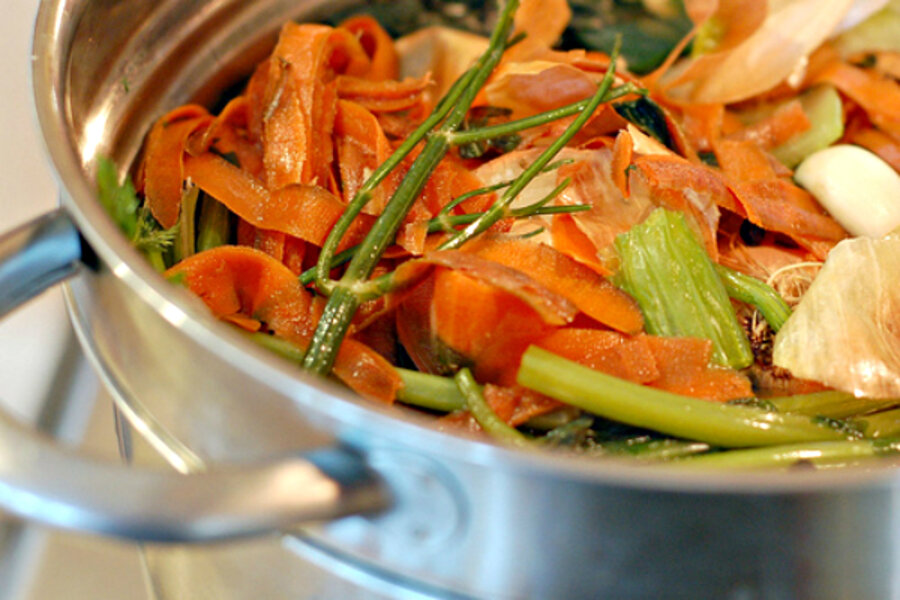Meatless Monday: Homemade vegetable stock
Although I love making soup, it's always bothered me that making stock feels so wasteful. As the child of one of the world's thriftiest people (love you, mom!), the idea of tossing a whole bunch of gorgeous carrots, celery, onions, and herbs into the pot, only to remove them all a little while later, replacing them with new veggies that would feature in the actual soup, has always rubbed me the wrong way.
And buying cartons of stock is expensive and those cartons may or may not actually be recyclable (never mind whether my garbage company actually recycles the stuff it claims to recycle...) so that was not really doing it for me either. But then, a couple months ago, I saw a post on Facebook about making vegetable stock from kitchen scraps! My prayers had been answered.
So I started saving some of the veggie scraps (more below on which ones are best to use and which ones you should avoid) that would otherwise have gone straight into the compost bucket. I stored them in one of this one-gallon Ziploc bags in my freezer. Since I like to cook and I like vegetables, they started piling up pretty quickly.
Then I followed the incredibly simple instructions (basically, cover them with water, bring to a boil and simmer for one hour, then strain) to make my own homemade vegetable stock.
And guess what? It's good! It was easy. It was free. And absolutely no vegetables were wasted in its making. Once I was done with those scraps, they got tossed on the compost heap, too.
Now we've got several containers of the stuff in our freezer, waiting for the next time we want to make some delicious soup. We also did an ice cube tray or two as it's great to have some smaller units of stock on hand if you just need to de-glaze a pan or add a little bit of liquid to something but don't want to go whole hog and defrost an entire yogurt container (those are our freezing containers of choice for bigger, liquid-y stuff) of the stuff.
The only thing I plan to change is omitting onion skins as I think I might prefer a clearer-looking stock – onion skins add nice flavor but also darken the color considerably. This is totally up to you, though.
So get scrappy and then get simmering! Once you're fully stocked, I've got a short list of delicious soups you might want to try your stock on at the bottom of this post.
Homemade Vegetable Stock From Kitchen Scraps
Makes roughly 3 quarts
Veggies To Save
Onions, carrots, and celery form the backbone of veggie stock, but don't stop there! Lots of other veggies add sweetness and flavor: leeks, scallions, garlic, onions (see my note below), fennel, chard, lettuce, potatoes, parsnips, green beans, pea pods, zucchini and other squash, bell peppers, eggplant, mushrooms, asparagus, corn cobs (think sweet!), winter squash skins, beet greens, and herbs like dill, thyme, parsley, cilantro and basil. You can use anything that is beginning to lose its luster but steer clear of anything that has actually gone bad, of course.
Veggies to Skip
These vegetables tend to overpower the stock flavor-wise (and some of them turn a bit bitter) so you may want to dump them directly on the compost heap, instead: cabbage, Brussels sprouts, broccoli, cauliflower, turnips, rutabagas, artichokes. And skip anything rotten or moldy.
Veggies You May Want to Skip
You can use beet root scraps and onion skins but just be aware that they will make your stock either a deep red or a deep brown so you may want to skip them. I plan to skip 'em in the future.
Storing the Scraps
You will want to collect roughly 4-6 cups of vegetables to make 2 quarts of stock. You can either save your scraps throughout the week in a large Ziploc or some other airtight container in the fridge, or if you're collecting scraps for longer than a week, just keep them in the freezer (this is what I do.)
Making the Stock
1. Place roughly 4-6 cups of scraps in a 5 quart stock pot. Add 1-2 bay leaves and a few black peppercorns.
2. Cover it all with cold water then bring it to a boil. Lower the heat to medium and simmer uncovered for about an hour. Any more than an hour and the flavor will begin to deteriorate.
3. Strain vegetables using a fine mesh strainer or a colander and giving them a press to make sure you get all the broth. Quick tip: I made mine in my steamer pot from Ikea which made the straining incredibly easy since all the veggies were in the steamer insert and I just lifted it out of the pot once it was done. Let cool then pour into glass jars, clean yogurt containers or freezer bags. Let cool completely in the fridge and then freeze or store for up to five days in the fridge.
Related post on The Garden of Eating: Carrot Soup with Orange & Ginger






